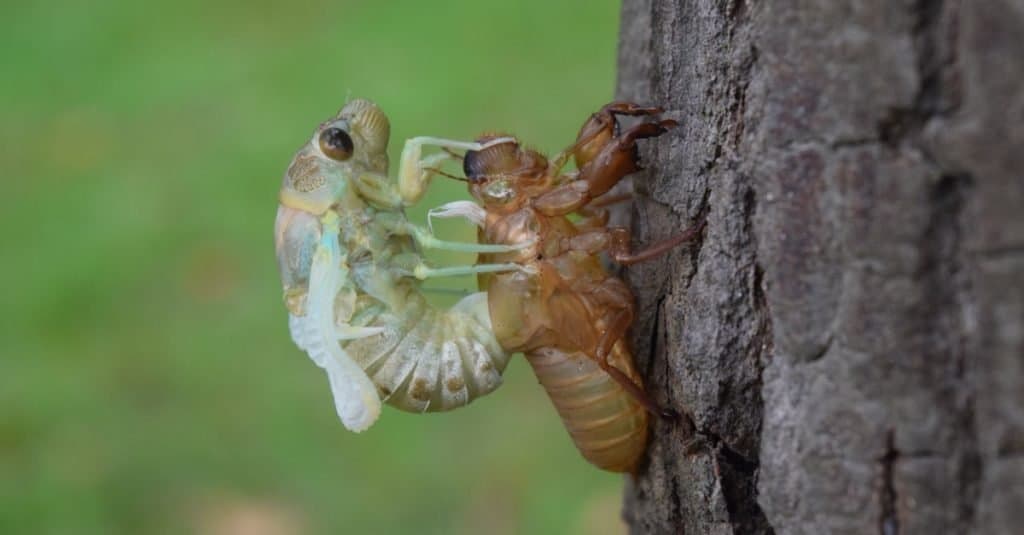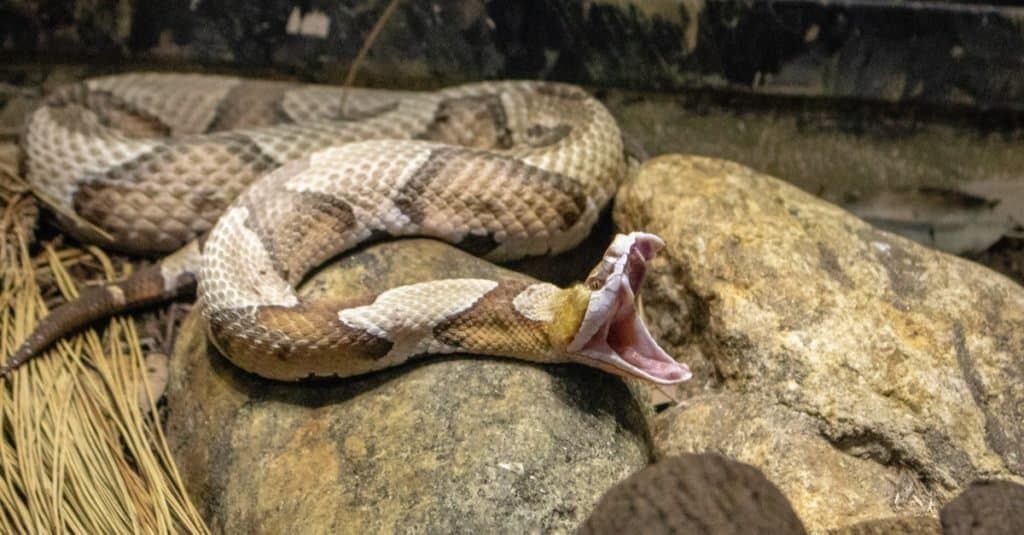Cicada Brood X is due to emerge from the ground in 2021 in 15 states across the eastern and central United States. One of the many concerns for residents and wildlife enthusiasts alike is whether the extra presence of cicadas will increase local snake populations. Maybe you’re worried about avoiding snake bites or simply curious about the impacts of such an event on the local ecosystem. Either way, it’s hard to deny that the upcoming cicada emergence is some of the most exciting environmental news of the year.
And one question we’re getting a lot right now is whether cicadas bring more copperheads. Read on to discover!
Preparing for an Abundant Cicada Population
The cicada population that emerging from the ground this year is estimated to be in the billions. This is a truly staggering number of insects, so it’s no surprise that tourists from around the country are making plans to witness this amazing event that only happens once every 17 years.
Humans aren’t the only observers who are excited about the cicada emergence. Local carnivores and omnivores, from birds to moles to snakes to foxes, almost always dine well during cicada season. Because of this, locals often notice an apparent increase in animal populations, especially around the areas where the cicadas are due to appear. Without the ability to read a news bulletin, we can only assume that these predators can hear the cicadas coming to life beneath the Earth’s surface.
Why Cicadas Are Such Easy Prey

©tienduc1103/Shutterstock.com
Cicadas are peaceful creatures with no natural defenses. When they first emerge from the ground, they are often disoriented and vulnerable. After crawling onto the surface, the cicada nymph crawls to a nearby tree and begins the molting process. Cicadas are completely immobile during molting, making them incredibly easy prey. If they make it through molting, they’ll turn into an adult cicada and gain the ability to fly.
Cicadas almost always emerge in massive numbers. There’s something magical about billions of bug crawling out of the earth, molting, then immediately flying into the air. However, because their numbers are so high, the presence of predators is important to ensure a limited impact on the environment. Cicadas get caught at all points of their short above-surface life cycle, which lasts for about 6 weeks.
The survival tactic that the cicadas use to survive this high carnivore presence is predator sedation. Essentially, the cicadas emerge from the ground in such high numbers that their predators quickly get full. That way, no matter how many cicadas succumb to local predators, plenty will survive to create the next generation. Because the cicadas only live above the surface for a few short weeks, it’s not surprising that they use such a self-sacrificing tactic to ensure their young’s success.
During their life cycle, cicadas lay eggs on as many plant surfaces as they can. Eggs hatch 6 weeks after the females lay them. The baby cicadas then burrow into the ground, look for roots to eat from, and immediately begin their 17-year underground lives. Every clutch contains around 600 eggs, meaning that there are almost plenty of cicadas to start the next generation.
Will There Be More Copperheads During Cicada Season?
One environmental myth that gets repeated often is that there are more snakes around during cicada season. While it’s true that the presence of such easy prey is incredibly attractive to predators, many people question whether or not the snake population is actually higher during these events.
The real truth is that cicada emergence draws preexisting snakes out of hiding. Copperhead snakes live all throughout the Pennsylvania forests; you just don’t usually notice them because they are so good at keeping themselves from sight. Snake populations are already difficult to estimate, but there seems to be no reason to believe that more snakes would appear during this event. Any snakes that are found basking on rocks or snapping up cicadas have simply crawled out of their dens for this momentous occasion.
Another theory that goes around is that snakes travel across great distances to reach cicada spawning grounds. Researchers have confirmed that copperheads will travel up to a mile from their normal habitat to attend the cicada feast. However, distances greater than this are too dangerous for normal copperhead travel.
How Cicadas Increase Snake’s Chance of Survival

©Suzanna Ruby/Shutterstock.com
Only snakes that are already present are capable of attending a cicada feast. However, one of the many effects of cicada season is that any snake populations that were able to enjoy the cicada harvest will likely survive longer and reproduce in greater numbers. Many young snakes are usually born in the year following a cicada emergence. This population burst will last until resources start to dwindle and a natural decline begins.
Many observers like to note that copperhead snakes are venomous and incredibly talented hunters that don’t necessarily need to eat cicadas to survive. However, with such an abundant source of delicious food available, these high-end predators seem to have no problem relaxing and dining with abandon. Photographers love to snap pictures of copperheads swallowing whole cicadas at once.
Protecting Yourself from Snakes While Cicada Watching
If you’re heading out into the woods to observe cicadas and take photos, you should take care to make sure you don’t accidentally cross paths with a startled copperhead.
Copperheads bite more people in the United States than any other snake. This is because they are so good at camouflaging and freezing to avoid detection that people stumble upon copperheads and surprise them frequently. Fortunately, these snakes usually start off with a non-venomous warning bite. But in the event that a startled snake uses its hemotoxic venom, the bite is extremely painful and causes nausea and swelling, requiring hasty treatment.
It’s a good thing copperhead bites are rarely fatal. But you still don’t want a surprise run-in. So here are a few tips to ensure that you stay safe during your summer adventure:
- Know what kinds of places snakes hang out in.
- Stay at least 10 feet away from copperheads. Once you get closer, you risk an actual bite.
- Walk slowly when approaching rocks, trees, and other areas where a copperhead might be lurking. Startling these snakes is the easiest way to get bitten.
- Wear tall shoes made from leather or another thick material. Even if you get nipped, the shoe should keep you safe.
- If a snake bite happens, call 911 immediately and stop moving to make sure the venom doesn’t spread.
Cicada emergence is an amazing spectacle, and seeing the snakes enjoy the fun makes it that much better. This year, take a moment to notice both the magical bug emergence and the many animals who are enjoying this rare but delicious bounty.
Cicada Brood X News & Information
Brood X is currently (spring 2021) emerging on the east coast of the United States. More information and coverage can be found here!
- Cicadas in New York: What’s Happening Now?
- Cicadas in Pennsylvania: What’s Happening Now?
- Cicadas in Virginia: What’s Happening Now?
- Cicadas in Tennessee: What’s Happening Now?
- Cicadas in Washington, DC: What’s Happening Now?
- Cicadas in Maryland: What’s Happening Now?
- Here’s What 1.5 Million Cicadas Looks Like
- Will Cicadas Cause More Snakes? Copperheads?
- Can Dogs Eat Cicadas?
- Will Cicadas Eat My Tomato Plants?
- Cicada Brood X 2021: What is it and should you be concerned?
Next Up…
- Cicadas Lifespan: How Long Do Cicadas Live?: Do cicadas live long? Find out about their life here.
- Why Do Cicadas Only Come Out Every 17 Years?: What is the secret behind this 17 year cycle? Find out here.
- Cicadas vs Locusts: What’s The Difference?: Are cicadas same as locusts? Find out here.
The photo featured at the top of this post is © Vaclav Sebek/Shutterstock.com
Discover the "Monster" Snake 5X Bigger than an Anaconda
Every day A-Z Animals sends out some of the most incredible facts in the world from our free newsletter. Want to discover the 10 most beautiful snakes in the world, a "snake island" where you're never more than 3 feet from danger, or a "monster" snake 5X larger than an anaconda? Then sign up right now and you'll start receiving our daily newsletter absolutely free.
Thank you for reading! Have some feedback for us? Contact the AZ Animals editorial team.






